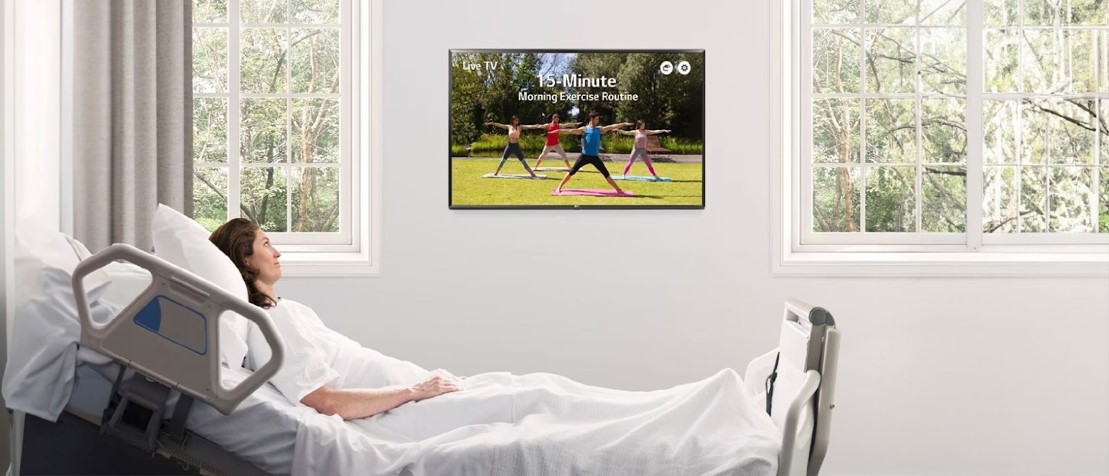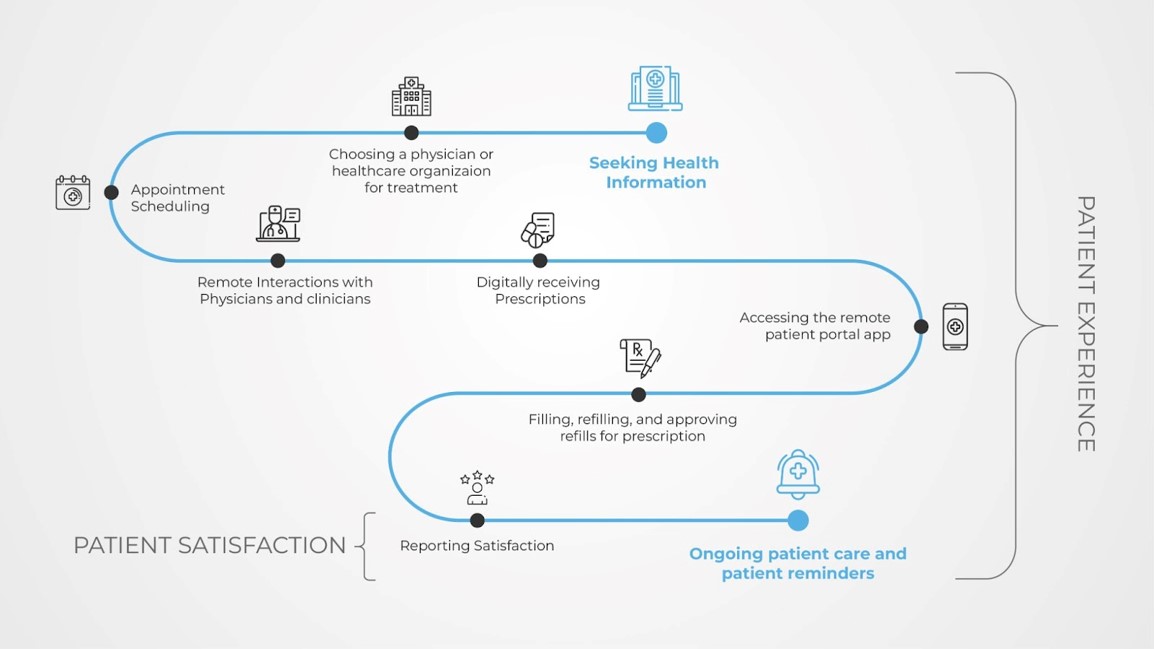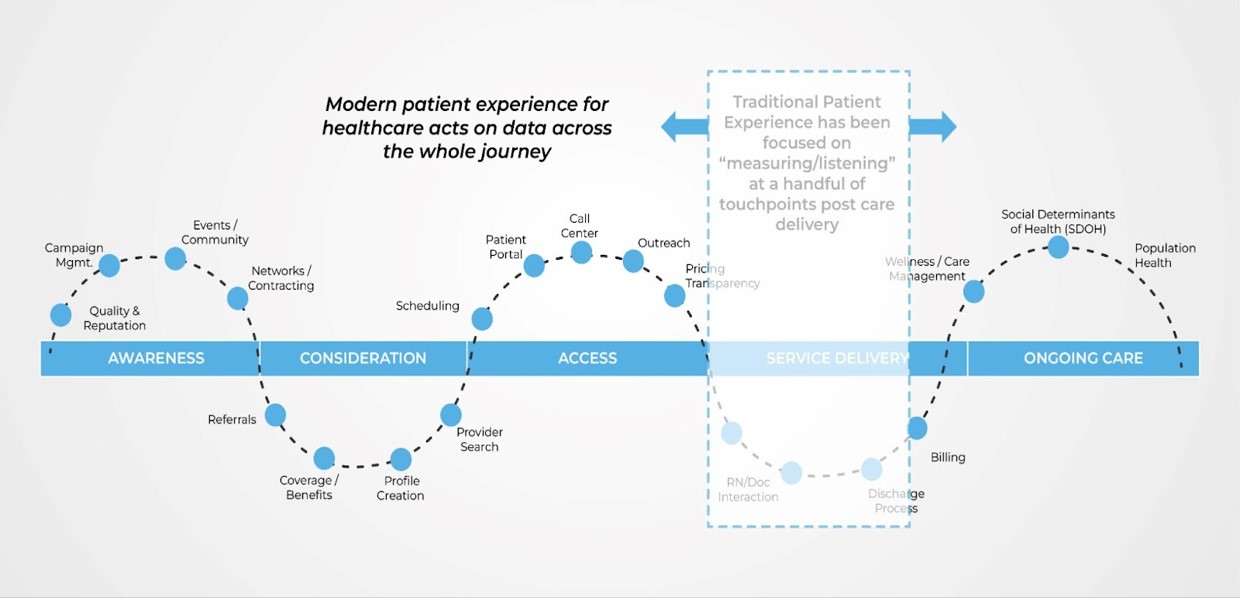
Healthcare digital strategists often confuse patient experience with patient satisfaction. But there’s a critical difference between the two which can dictate whether or not a consumer comes back to you.Â
Patient satisfaction is the subjective expectations patients have from your healthcare services. It’s typically the go-to metric for most healthcare providers.Â
The problem? Patient satisfaction scores offer a frighteningly limited and isolated view of the overall patient journey, all captured in a measly feedback form. This means that a 5-star rating for a physician can easily cloud a shoddy waiting room or appointment booking experience that drives customers away.
Patient experience, on the other hand, is your patient’s overall journey with your brand – from when they visit your website or find you in a listing, to post-healthcare delivery.
The driving force behind exceptional delivery and measurement of patient experience? Technology.
Visualizing the modern patient journey
As is the case with any consumerized industry, in today’s consumerized healthcare landscape, patient experience is a key differentiator reflecting a healthcare provider’s performance. This means how patients feel about their treatment and experience at your facility can often reflect the provider’s competence and care quality.Â
But, evaluating care quality can be challenging because it is not exactly quantifiable or tangible. However, surveys like the HCAHPS (the Hospital Consumer Assessment of Healthcare Providers and Systems survey) are a good way of gauging a patient’s overall experience with your healthcare brand.
As patients are active consumers in other industries besides healthcare, your benchmark is set by their customer experience (CX) with companies in other sectors as well. For instance, consumer brands like Netflix and Google provide exceptional CX to which your customers compare their experience.
This shift from mere visit satisfaction to the encompassing experience emphasizes the need for healthcare providers to focus not only on clinical outcomes — but also on the quality of interactions and services they provide to patients in the entire patient journey, assisted by innovative technologies.

How tech drives better patient experiences
Digital transformation has quickly gone from a buzzword in healthcare to a very serious talking point (and focus) in global healthcare boardrooms.Â
The reason is simple: technology can fundamentally shape patient relationships, drive better patient experiences — and seriously impact bottom lines. But how?
Here are some demonstrative examples.
1. Optimizing patient engagement experiences pre-appointment / visit.
One of the biggest frustrations patients feel is their forced interactions with outdated and inconvenient healthcare processes. From in-person visits to post-treatment management, patients seek smoother alternatives.
This is why many healthcare providers are moving to Patient Relationship Management (PRM) software that makes it easy to schedule appointments online, opt for video consultation, get pre-visit reminders, and access multiple booking options.Â
The results are there for everyone to see: 8 out of 10 providers that use PRMs say that it facilitates better communication with patients, and reduces no-shows to 10% or less.
2. Improving and accelerating administrative processesÂ
Technology is quickly forming the foundation of smooth healthcare ops and admin processes, with knowledge management systems (KMS) and digital signage at the forefront.
- KMS: Provides your healthcare staff with a single source of truth to ensure all information across your healthcare facility is updated and consistent. Â
- Digital signage: Helps you communicate important real-time updates like schedules, healthcare guidelines, and emergency messages with your staff through immersive and dynamic displays. This way, your staff does not miss important updates buried in their emails or texts. Up to a 25% increase in employee productivity is observed after employing digital signage for internal communication.Â
3. Optimizing patient communication and coordination for in-patients.
Hospital visits can be anxiety-inducing experiences. Easing this anxiety in small yet thoughtful steps can go a long way in creating more welcoming patient experiences. There’s tech that exists for exactly this.
Simplified wayfinding
For many patients, running around to find their doctor’s rooms and labs can be a frustrating experience. It wastes time, confuses patients, and can significantly slow down operations.
With wayfinding digital signage, you can guide your patients throughout your facility with large displays of your facility layout. You can also introduce interactive kiosks to help patients with the right directions without hassle.Â
Additionally, enabling patients to scan relevant QR codes is also an advanced wayfinding solution through digital signage.Â
Real-time updates
Long patient wait times are a massive challenge for healthcare facilities to solve, and some of the biggest healthcare brands in the world are solving for this with real-time digital communication.
Take for instance Lifelabs — Canada’s largest medical laboratory that serves a whopping 100,000 patients every day. Long waiting times are practically business killers for a healthcare enterprise of this scale.Â
The fix? Digital communication software and displays that brought down perceived waiting times by 33%!
Streamlined patient registration and queueingÂ
Digital signage helps streamline patient intake in hospitals and clinics by providing clear directions and next-in-line information.Â
Patients can also scan QR codes to register directly without the need to stand in long queues. This helps reduce confusion and congestion for smoother in-take and queue management.
Work with your CTO to bring in the right techÂ
1. Mapping the patient journeyÂ
For healthcare organizations, achieving a seamless patient experience means focusing on the different stages of the patient journey. This helps you understand the exact challenges that patients face during each phase.Â
Consider these gaps in your evaluation:
- Awareness: This is where your patient identifies their need for care and searchers for possible healthcare providers. Possible gaps include non-intuitive design and slow website responsiveness.Â
- Consideration: During this stage, patients analyze if your facility meets their needs. Some challenges they might face are incomplete website information, broken contact links, and in-facility accessibility.Â
- Access: Here is the highest point of direct patient engagement via calls, portals, text messages. This is where a robust PRM can help manage online scheduling, video conferencing, and setting reminders.Â
- Service delivery: During the actual in-facility visit, possible challenges for patients include navigation, registration, and real-time updates. These issues can be effectively addressed by dynamic displays using digital signage.
Post-service: This refers to overall wellness and care management after the actual consultation. You can send health reports, checkup reminders and more using a versatile PRM system.

2. Identify and evaluate relevant technologies
Once you’ve identified the gaps in your patients’ journey, the next task is to evaluate and implement innovative solutions to close these gaps. Here’s a list of essential tools to streamline healthcare management:
- Employee Communication System: Digital communication is a big game-changer in real-time communication with staff. This is achieved through targeted displays through which you can share all patient-care-related information and guidelines. Using a cloud-based CMS, you can easily update guidelines, protocols, and schedules from a centralized dashboard.Â
- Waiting Room & Patient Room TVs act as stress busters and information hubs to calm hospital anxiety. Besides engaging your patients, they are also a great way to display ads about your other products and services to keep patients informed.
- Digital Room Placards allow you to update doctor and patient information easily. They eliminate the need to manually replace information with every schedule change or update.
- Telemedicine: This technology allows doctors to see and treat patients through online video consultations, eliminating the need for in-person checkups.Â
- Electronic Health Records: This modern technology enables patients and doctors to get a quick and easy overview of a patient’s entire health history to provide more contextual patient care.
- Patient relationship management (PRMs): This software allows patients to schedule online appointments, get reminders, make multiple check-in options, access data analytics, and submit actionable feedback.
- Waiting Room TVs: With 97% of patients frustrated with long wait times, using waiting room TVs to engage patients has brought it down significantly to 33%!
The right tech stack at your healthcare facility will ensure you deliver quality patient care like never before. Some of the major impacts include:
- Adopting to real, busy lives of patients with flexible consultation options Â
- Making healthcare more accessible with healthcare experts available on-demandÂ
- Creating more immersive and welcoming patient experiences in your facilityÂ
- Gathering actionable patient-driven data by sharing feedback and improvement surveys that patients can answer at their convenienceÂ
3. Measure impact of tech spend
Finally, the last step is all about measuring the impact of your tech implementation. This is a crucial step of your journey as it will give you insights on what’s working and what needs improvement.
Here are the key parameters to keep track of:
- Net Promoter Score (NPS): This metric asks patients a simple question – “On a scale from 0 to 10, how likely are you to recommend this center to your family or friends?â€A low NPS means that your healthcare center is at a high risk of losing its customers/patients. Using this score, your team can perform root cause analysis to improve the quality of services.

- Customer effort score (CES): This metric indicates how easy it is for patients to access the care they need from your healthcare system across touchpoints. High effort scores means that patients have to put in a lot of effort to avail the help they need. Thus, the higher the customer effort score, the lower loyalty.

- Patient retention rate (PRR): This metric calculates the percentage of patients who continue to use the services of a healthcare provider or facility over a specific period.

Embrace innovative tech for seamless patient experiences
All things considered, CTOs are the captains steering healthcare organizations toward a tech-driven future. Overlooking the crucial role of technology in patient experience strategies can be a missed opportunity that will set your healthcare brand back irreparably.
As customer expectations evolve, your patients are no exception—they crave more personalized and friendlier experiences. As these patient needs evolve, leveraging technology becomes a must-have, not just a nice-to-have. Whether it’s streamlined communication systems or personalized healthcare services, technology doesn’t just enhance operational efficiency; it creates a patient-centric world.
That’s why embracing innovative technology goes beyond keeping up with a “trend†but more so about redefining patient care as an industry leader. Integrating cutting-edge technology is a strategic must for fostering innovation, efficiency, and ultimately, seamless patient experiences.



Facebook Comments